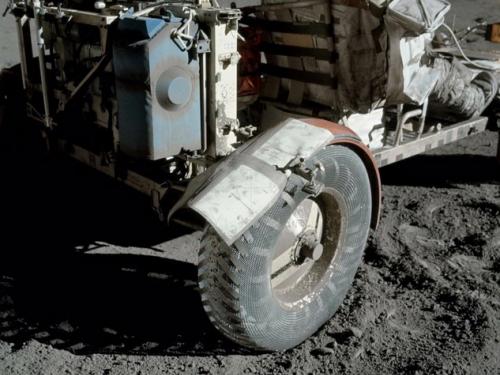
Stories of daring, stories of technological feats, stories of prevailing against the odds ... these are the stories we tell at the National Air and Space Museum. Dive in to the stories below to discover, learn, and be inspired.
Showing 71 - 80 of 91

August 31, 2015
When most people think of emergency fixes in space, the first incident that comes to mind is the famous Apollo 13 mission. The astronauts fashioned duct tape and surplus materials into air filtration canisters in the lunar module to keep all three astronauts alive for the entire trip home.

July 02, 2015
Much of the Moon is blanketed by a thick layer of dust, built up from the rocky surface over billions of years by the impacts of small meteorites. Hidden beneath the dust is evidence of ancient geologic activity – great volcanic eruptions, tectonic shifts in the crust, and vast deposits of once-molten material hurled outward during the formation of the giant impact basins.

January 20, 2015
It was particularly timely that during the hustle and bustle of the 2014 holidays, I, along with curators Jennifer Levasseur and Cathleen Lewis, had a very special package to open for the very first time.

July 24, 2014
There is no question that the success of Project Apollo in the 1960s helped to create a culture of competence for NASA that translated into a level of confidence in American capability, and especially in the ability of government to perform effectively, to resolve any problem. Something that almost sounds unthinkable in the early twenty-first century but such was indeed the case in the 1960s.

April 14, 2014
If you live in North America or western South America, you have a treat in store for you tonight or early tomorrow morning: a total lunar eclipse! If you live elsewhere in the world, or if it’s cloudy in your location – as it probably will be tonight at our location in Washington, DC – you can still see the eclipse online. Several websites will host live streams. Some of their locations will be clouded out, so we recommend that you search for “lunar eclipse live stream” and browse the results. You can also participate in a live web chat during the eclipse with NASA astronomers.
December 26, 2013
As our northern hemisphere days begin to lengthen, I like to think about the many ways people have marked the Winter Solstice throughout human history. Like Summer Solstice (the longest day), the equinoxes, and motions of the planets and Moon through the sky, Winter Solstice has long been observed, recorded, and used to construct special buildings. Some of these buildings were erected so long ago that no written record of their use is available today, but they clearly point at cultures that valued the knowledge of precisely when the longest night of the year occurs. Two ancient cultures in the northern hemisphere whose monuments I’ve visited come to mind: Celtic and Anasazi.

July 24, 2013
One of the primary objectives in the Museum’s previous collection surveys has been to identify artifacts which are actively deteriorating and require stabilizing treatments prior to being relocated to the new storage facility at the Steven F. Udvar-Hazy Center in Chantilly, Virginia. These artifacts with active corrosion, mold contamination, hazardous materials, and physical insecurities were set aside for a team of three contract conservators to perform specialized treatments.

October 18, 2012
In July, I joined a team from Johnson Space Center and elsewhere in investigating the geology of Apollo Valley with rover-deployed scientific instruments. Apollo Valley is a former 1960s Apollo-era astronaut training site at 3,505 meters (11,500 feet) on Mauna Kea, Hawaii. The project was funded by NASA's Moon and Mars Analog Mission Activities Program, which funds projects that simulate scientific, robotic, and human aspects of exploring the Moon and Mars, with the goal of designing the most effective, efficient, and well-integrated future missions.

August 25, 2012
We will all miss him, not just because he was the first human being in the history of the world to set foot on another body in the solar system, but perhaps especially because of the honor and dignity with which he lived his life as that first Moon walker.

May 11, 2012
If you visit the Public Observatory during its daytime hours in May (1–3pm on Wednesday through Saturday, weather permitting), you can use the 16” telescope to observe an object which looks a lot like the Moon. Hanging in a blue sky, it shines with yellowish reflected sunlight.